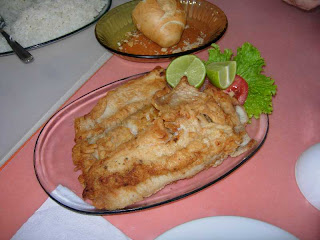On Saturday the school took the teachers and staff members on a school trip to a nearby town called
Rio Pardo. The school organizes trips about once a month of varying types and lengths - transportation is provided and we pay our own meal expenses. This is a lovely thing for them to do as it showcases local points of interest which we might not otherwise find on our own, as well as gives us a chance to hang out with the Brazilian staff members in a relaxed environment.
Rio Pardo was the former county seat of the area. The river travels from quite far inland all the way to Porto Alegre, and Rio Pardo is about in the middle, so it was no doubt strategically important both militarily and commercially.
Here is the school van sitting in the dirt (mud) parking lot; we had just arrived at the river where we were going to eat lunch in a restaurant. There was a family fishing with a barbecue set up on the water's edge.
The water level is pretty high as one can see from the submerged trees here.
The white specks on the opposite side of the river were herons (I could see them in a photo taken by a friend who has a more powerful camera).
The group gathered around the van - what a bunch of tourists!
The parking lot was pretty muddy, so there was a makeshift boardwalk to get to the door of the restaurant.
Boingy, boingy!
The restaurant here is on pontoons so that it can be dragged around as the water's edge rises and recedes. Fortunately, either it was grounded or the movement of the river was very slight so as not to upset the dining.
The specialty here is fried freshwater fish. I was extremely surprised to see the sliced French bread is eaten on the plate with knife and fork here, and was very grateful that I hadn't just grabbed a piece and started munching on it!
One of the town's famous old churches, Igreja Matriz Nossa Senhora do Rosário, built in 1779.
The cherubs on the detail here look soooooo much like sumo wrestlers! Which reminds me, I haven't been following the world of sumo the last couple of years... but I digress.
This stone street, Rua Julio de Castilhos (Rua da Ladeira), was the first stone street in the state of Rio Grande do Sul and was originally built by slaves in 1813. If I understood correctly, it was built for a visiting emperor or king to go from the river to the town.
The ornate round window here is to a basement area which was originally the slave quarters. This house was not open to the public when we were there, but it is historically preserved.
A distant view of the same house; the round window is down by the gate on the left.
The Rua de Ladeira's current name is Rua do
Júlio de Castilhos.
Forte Jesus, Maria, José do Rio Pardo was a ruin of an old fort, on top of which now sits a water treatment plant. The area is overgrown, but the cannon are overlooking the river.
Another of the foreign teachers seeking the perfect photo.
The water treatment maze.
That is not a stray dog, it's a pony. Some people in this town still use a pony cart to transport goods, although I didn't get a photo of a cart in action.
Along the side of another old church was this mini shrine. We were moving so the photo is a bit blurred.
Back view of another church, the Capela São Francisco, built in 1755 and one of the oldest in the colony.
And the front view.
The guy is standing in the doorway of a barbershop.
The bustling downtown of Rio Pardo.
We took a tour of a historic building, built in 1847, that began as a hospital, turned into a military academy, and is now a community center and monument called
Casa de Cultura de Rio Pardo. The famous Brazilian personage Getulio Vargas attended this academy.
The tour guide explaining the various relics.
Some magnificent gold thread embroidery.
There were windows like the one shown in the second photo down at the front and back of the building; the one in the front had the light hitting it just beautifully at this moment.
A marching band was practicing back and forth in the courtyard the entire time we were touring the building.
The carvings holding the light fixtures were gorgeous.
Another view of the colored light hitting the steps.
The front of the building.
And another ancient church next door, the
Capela do Senhor dos Passos, built in 1812.
Another street view downtown.
We stopped for hot chocolate and coffee here. There were some truly decadent offerings. I got a "Napolitano", which was thick hot chocolate with a scoop of strawberry ice cream, topped with whipped cream. Strangely, like baked Alaska, the ice cream stayed cold and the chocolate stayed hot!
On the way home we took a little detour through some country roads. The people on the motorcycle were wearing ponchos that flapped around their legs.
These kids on horseback started smiling and waving and showing off when they saw the cameras!
The perfect end to a lovely trip.


































































